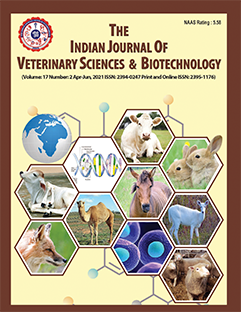Treatment Outcomes of Mandibular Fractures in Dogs: A Retrospective Study of 24 Cases
DOI:
https://doi.org/10.48165/ijvsbt.21.5.031Keywords:
Dog, Fracture, Mandible, Road traffic accidentAbstract
Mandibular fractures present unique surgical challenges due to their anatomical complexity. This retrospective study of 24 dogs examines fracture patterns, management strategies, and outcomes. Road traffic accidents were the predominant etiology (n=13), followed by dog bites (n=7), falls (n=3), and horse kicks (n=1). Patients were presented with signs of oral bleeding, jaw mal-alignment, swelling, and reluctance to eat. A high incidence occurred in dogs under one year (n=12) and Indian Pariah breed (n=20), with males predominating (n=16). Bilateral fractures occurred in 13 cases, while 8 had multiple fractures. Fracture distribution was: canine-premolar region (n=10), symphyseal separation (n=6), third-fourth molar region (n=4), last molar-ramus (n=4), incisor-canine (n=3), first-second molar (n=3), with one concurrent maxillofacial fracture. Stabilization techniques employed were circumferential wiring, K-wires, plates (cuttable, SOP), and external fixation. Postoperative care included soft diet, antibiotics, analgesia, and antiseptic rinses.
Downloads
References
Castejon-Gonzalez, A.C., Stefanovski, D., & Reiter, A.M. (2022). Etiology, clinical presentation, and outcome of mandibular fractures in immature dogs treated with non-invasive or minimally invasive techniques. Journal of Veterinary Dentistry, 39(1), 78–88.
Copcu, E., Sisman, N., & Oztan, Y. (2004). Trauma and fractures of the mandible: Effects of aetiological factors on fracture patterns. European Journal of Trauma and Emergency Surgery, 30, 110–115.
De La Puerta, B., Emmerson, T., Moores, A.P., & Pead, M.J. (2008). Epoxy putty external skeletal fixation for fractures of the four main metacarpal and metatarsal bones in cats and dogs. Veterinary and Comparative Orthopaedics and Traumatology, 21(5), 451–456.
Glyde, M., & Lidbetter, D. (2003). Management of fractures of the mandible in small animals. In Practice, 25(10), 570–585.
Guzu, M., & Hennet, P.R. (2017). Mandibular body fracture repair with wire-reinforced interdental composite splint in small dogs. Veterinary Surgery, 46(8), 1068–1077.
Harasen, G. (2008). Maxillary and mandibular fractures. Canadian Veterinary Journal, 49(8), 819–820.
Kitshoff, A.M., de Rooster, H., Ferreira, S.M., & Steenkamp, G. (2013). A retrospective study of 109 dogs with mandibular fractures. Veterinary and Comparative Orthopaedics and Traumatology, 26(1), 1–5.
Lopes, F.M., Gioso, M.A., Ferro, D.G., Leon-Roman, M.A., Venturini, M.A., & Correa, H.L. (2005). Oral fractures in dogs of Brazil - A retrospective study. Journal of Veterinary Dentistry, 22(2), 86–90.
Lorinson, K., Loebcke, S., Skalicky, M., Grampp, S., & Lorinson, D. (2008). Signalment differences in bone mineral content and bone mineral density in canine appendicular bones. A cadaveric study. Veterinary and Comparative Orthopaedics and Traumatology, 21(2), 147–151.
Shamir, M.H., Leisner, S., Klement, E., Gonen, E., & Johnston, D.E. (2002). Dog bite wounds in dogs and cats: A retrospective study of 196 cases. Journal of Veterinary Medicine Series A: Physiology, Pathology, Clinical Medicine, 49(2), 107–112.
Verstraete, F.J.M. (2003). Maxillofacial fractures. In: Slatter DH, editor. Textbook of Small Animal Surgery, 3rd ed., Philadelphia, PA, Saunders, pp. 2190–2207.
Downloads
Published
Issue
Section
License
Copyright (c) 2025 Indian Journal of Veterinary Sciences and Biotechnology

This work is licensed under a Creative Commons Attribution-NonCommercial-NoDerivatives 4.0 International License.




